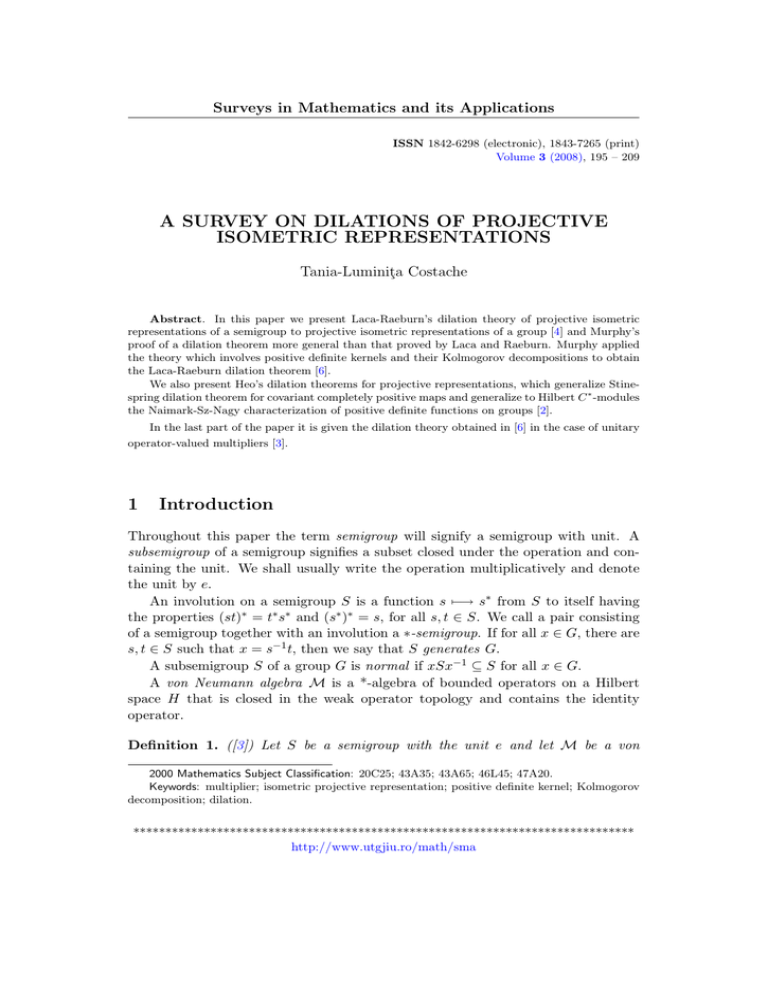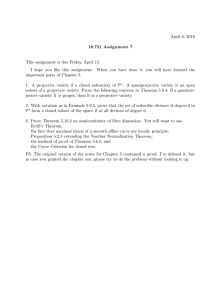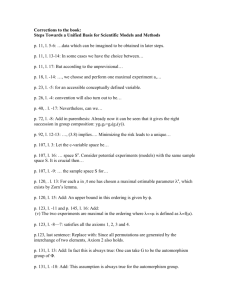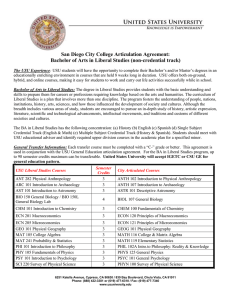A SURVEY ON DILATIONS OF PROJECTIVE ISOMETRIC REPRESENTATIONS Tania-Luminit¸a Costache
advertisement

Surveys in Mathematics and its Applications ISSN 1842-6298 (electronic), 1843-7265 (print) Volume 3 (2008), 195 – 209 A SURVEY ON DILATIONS OF PROJECTIVE ISOMETRIC REPRESENTATIONS Tania-Luminiţa Costache Abstract. In this paper we present Laca-Raeburn’s dilation theory of projective isometric representations of a semigroup to projective isometric representations of a group [4] and Murphy’s proof of a dilation theorem more general than that proved by Laca and Raeburn. Murphy applied the theory which involves positive definite kernels and their Kolmogorov decompositions to obtain the Laca-Raeburn dilation theorem [6]. We also present Heo’s dilation theorems for projective representations, which generalize Stinespring dilation theorem for covariant completely positive maps and generalize to Hilbert C ∗ -modules the Naimark-Sz-Nagy characterization of positive definite functions on groups [2]. In the last part of the paper it is given the dilation theory obtained in [6] in the case of unitary operator-valued multipliers [3]. 1 Introduction Throughout this paper the term semigroup will signify a semigroup with unit. A subsemigroup of a semigroup signifies a subset closed under the operation and containing the unit. We shall usually write the operation multiplicatively and denote the unit by e. An involution on a semigroup S is a function s 7−→ s∗ from S to itself having the properties (st)∗ = t∗ s∗ and (s∗ )∗ = s, for all s, t ∈ S. We call a pair consisting of a semigroup together with an involution a ∗-semigroup. If for all x ∈ G, there are s, t ∈ S such that x = s−1 t, then we say that S generates G. A subsemigroup S of a group G is normal if xSx−1 ⊆ S for all x ∈ G. A von Neumann algebra M is a *-algebra of bounded operators on a Hilbert space H that is closed in the weak operator topology and contains the identity operator. Definition 1. ([3]) Let S be a semigroup with the unit e and let M be a von 2000 Mathematics Subject Classification: 20C25; 43A35; 43A65; 46L45; 47A20. Keywords: multiplier; isometric projective representation; positive definite kernel; Kolmogorov decomposition; dilation. ****************************************************************************** http://www.utgjiu.ro/math/sma 196 T. L. Costache Neumann algebra on a Hilbert space H. The U(M)-multiplier on S is a U(Z(M))valued map defined on S × S satisfying : (i) ω(e, s) = ω(s, e) = 1; (ii) ω(s, t)ω(st, u) = ω(s, tu)ω(t, u), for all s, t, u ∈ S. Remark 2. ([3]) If M is a factor, i.e. Z(M) = CI, then the U(M)-multiplier coincides with the unit circle T-valued multiplier that we shall use in Section 2. Definition 3. ([3]) Let S be a semigroup with unit, let M be a be a von Neumann algebra on a Hilbert space H and let ω be a U(M)-multiplier on S. A projective isometric ω-representation of S is a map ρ : S → M having the following properties for all s, t ∈ S : (i) ρ(s) is an isometry and ρ(e) = 1; (ii) ρ(st) = ω(s, t)ρ(s)ρ(t). If ρ(s) is unitary for s ∈ S, we say that ρ is a projective unitary ω-representation. If ρ is a projective isometric ω-representation of a group G, then ρ is automatically a projective unitary ω-representation, in fact ρ(s)∗ = ω(s−1 , s)ρ(s−1 ) for all s ∈ G. Remark 4. In particular, if M = B(H), we obtain the definition of the projective isometric ω-representation that we shall use in Section 2. Definition 5. ([6]) Let X be a non-empty set, let H be a Hilbert space and let B(H) be the Banach algebra of all bounded operators on H. A map k from X × X to B(H) is a positive definite kernel if for every positive integer n and x1 , . . . , xn ∈ ∗ X, X the operator matrix (k(xi , xj ))ij in the C -algebra Mn (B(H)) is positive, i.e. hk(xi , xj )hj , hi i ≥ 0 for all h1 , . . . , hn ∈ H and x1 , . . . , xn ∈ X. i,j Definition 6. ([6]) If k can be written in the form k(x, y) = V (x)∗ V (y), where V : X → B(H, HV ), for some Hilbert space HV , then k is automatically positive definite. Such a map V is said to be a Kolmogorov decomposition of k. Moreover, [ if, in addition, HV is the closed linear span of the set V (x)H, then V is said to x be minimal. Definition 7. ([3]) Let G be a group, let M be a von Neumann algebra on a Hilbert space H and let ω be a U(M)-multiplier on G. We say that a map ϕ : G → M is ω-positive definite if the map k on G × G defined by k(x, y) = ω(x−1 , x)ω(x−1 , y)∗ ϕ(x−1 y) is positive definite. We define a (minimal) Kolmogorov decomposition for ϕ to be a (minimal) Kolmogorov decomposition for k. Remark 8. In particular, if M = B(H), we obtain the definition of the ω-positive definite map that we shall use in Section 2. ****************************************************************************** Surveys in Mathematics and its Applications 3 (2008), 195 – 209 http://www.utgjiu.ro/math/sma A survey on dilations of projective isometric representations 2 197 Dilation theory in the case of projective isometric representations on Hilbert spaces with T-valued multipliers The following theorem shows that an isometric ω-representation of S is always the restriction of a ω-representation of S by unitary operators to an invariant subspace. Theorem 9. ([4]) Suppose ω is a multiplier on a normal generating subsemigroup S of the group G and let ρ be an isometric ω-representation of S on a Hilbert space H. Then there is a unitary ω-representation ρ0 of S on a Hilbert space H 0 containing a copy of H such that (i) ρ0 (s) leaves H invariant and ρ0 (s)|H = ρ(s); [ (ii) ρ0 (s)∗ H is dense in H 0 . s∈S Proof. Let H0 be the set of functions f : S → H for which there is s ∈ S such that f (y) = ω(ys−1 , s)ρ(ys−1 )(f (s)) (2.1) for y ∈ Ss. Such s will be called admissible for f . Note that if s is admissible for f and r ∈ Ss, then r is also admissible for f , for then Sr ⊂ Ss and for all y ∈ Sr, f (y) = ω(ys−1 , s)ρ(ys−1 )f (s) = ω(ys−1 , s)ω(yr−1 , rs−1 )ρ(yr−1 )ρ(rs−1 )f (s) = ω(ys−1 , s)ω(yr−1 , rs−1 )ω(rs−1 , s)ρ(yr−1 )f (r) = ω(yr−1 , r)ρ(yr−1 )f (r), by Definition 1. Suppose now f and g are in H0 and s is admissible for both f and g (since S is normal, the product of an admissible value for f and one for g will do). If y ∈ Ss, then hf (y), g(y)i = ω(ys−1 , s)ρ(ys−1 )f (s), ω(ys−1 , s)ρ(ys−1 )g(s) = = hf (s), g(s)i , because ρ(ys−1 ) is an isometry and ω takes values in the unit circle. Thus hf (s), g(s)i is constant on the set of values of s which are admissible for both functions and we can define a positive semidefinite sesquilinear functional on H0 by hf, gi = hf (s), g(s)i, where s is any value admissible for both f and g. Let H 0 be the Hilbert space completion of H0 under the corresponding seminorm and notice that this identifies functions which coincide on an admissible set of the ****************************************************************************** Surveys in Mathematics and its Applications 3 (2008), 195 – 209 http://www.utgjiu.ro/math/sma 198 T. L. Costache form Ss. To embed the original Hilbert space H, define for each ξ ∈ H, the function b = ρ(s)ξ for s ∈ S. Since ρ is an isometric ω-representation, ξb satisfies (2.1) ξb by ξ(s) b The embedding for any s ∈ S, hence ξb ∈ H0 and every s ∈ S is admissible for ξ. b ξ −→ ξ is isometric because each ρ(s) is. Suppose now that f ∈ H0 and t ∈ S and consider the function ft defined by ft = ω(x, t)f (xt) for x ∈ S. If s ∈ S is admissible for f , then normality implies that st is also admissible for f , and since xt ∈ Sst, for any x ∈ Ss, ft = ω(x, t)f (xt) = ω(x, t)ω(xt(st)−1 , st)ρ(xt(st)−1 )f (st) = ω(x, t)ω(xs−1 , st)ρ(xs−1 )f (st) = ω(x, t)ω(s, t)ω(xs−1 , s)ω(xs−1 s, t)ρ(xs−1 )f (st) = ω(s, t)ω(xs−1 , s)ρ(xs−1 )f (st) = ω(xs−1 , s)ρ(xs−1 )ft (s) which shows that the same s is admissible for ft ; in particular ft ∈ H0 . Evaluating the inner product at a point s admissible for both f and g, we obtain D E hft , gt i = hft (s), gt (s)i = ω(s, t)f (st), ω(s, t)g(st) = hf, gi ; thus, ρ0 (t)f = ft for t ∈ S defines an isometry ρ0 (t) on H 0 . If ξ ∈ H, then b (ρ0 (t)ξ)(x) = ρ0 (t)ρ(x)ξ = (ρ(x))t ξ = ω(x, t)ρ(xt)ξ = [ ω(x, t)ω(x, t)ρ(x)ρ(t)ξ = ρ(x)ρ(t)ξ = ρ(t)ξ(x) for x ∈ S, so ρ0 (t) restricts to ρ(t) on the copy of H inside H 0 . Furthermore, ρ0 (s)ρ0 (t)f (x) = ω(x, s)ρ0 (t)f (xs) = ω(x, s)ω(xs, t)f (xst) = ω(x, st)ω(s, t)f (xst) = ω(s, t)ρ0 (st)f (x) for all x ∈ S and f ∈ H0 Thus ρ0 is a ω-representation of S by isometries and it remains to prove that these isometries are in fact unitaries. Let t ∈ S and suppose that s is admissible for g ∈ H0 . Consider the function defined by ω(xt−1 , t)g(xt−1 ), if x ∈ St gt−1 (x) = 0, otherwise Then st is admissible for gt−1 : if x ∈ Sst, then xt−1 ∈ Ss is admissible for g and gt−1 (x) = ω(xt−1 , t)g(xt−1 ) = ω(xt−1 , t)ω(xt−1 s−1 , s)ρ(xt−1 s−1 )g(s) = ****************************************************************************** Surveys in Mathematics and its Applications 3 (2008), 195 – 209 http://www.utgjiu.ro/math/sma 199 A survey on dilations of projective isometric representations ω(xt−1 s−1 , st)ω(s, t)ρ(xt−1 s−1 )g(s) = ω(x(st)−1 , st)ρ(x(st)−1 )gt−1 (st) so gt−1 ∈ H0 . Since ρ0 (t)gt−1 (x) = ω(x, t)gt−1 (xt) = ω(x, t)ω(x, t)g(x) = g(x) for x ∈ S, ρ0 (t) is surjective for every t ∈ S. Thus ρ0 is a unitary ω-representation of the subsemigroup S on H 0 , which finishes the proof of (i). To prove (ii), assume f ∈ H0 and fix s admissible for f . Then for x ∈ Ss, ρ0 (s)(f )(x) = ω(x, s)f (xs) = ω(x, s)ω(xss−1 , s)ρ(xss−1 )f (s) = ρ(x)(f (s)) = fd (s)(x) Hence f (x) = (ρ0 (s)∗ fd (s))(x) for x in the admissible set Ss, which implies f = 0 ∗ 0 d ρ (s) f (s) in H . Since H0 is dense in H 0 , (ii) follows. For the rest of this section, G will denote a group, ω a multiplier of G and S a normal, generating subsemigroup of G. The following result is a generalization of Naimark-Sz.-Nagy’s theorem of characterization of positive definite functions (Corollary 2.6, [1]), which can be obtained by taking ω ≡ 1. Theorem 10. ([6]) Let H be a Hilbert space and ϕ a ω-positive definite map on G with values in B(H). Then there are a Hilbert space H 0 , an operator T ∈ B(H, H 0 ) and a unitary ω-representation ρ of G on H 0 such that[ϕ(x) = T ∗ ρ(x)T , for all x ∈ G. Moreover, H 0 is the closed linear span of the set ρ(x)T H. x Proof. Let V be a minimal Kolmogorov decomposition of ϕ and set H 0 = HV . Let x, y, z ∈ G. Then it is easy to verify that ω(x−1 z −1 , zx)ω(z, x)ω(x−1 , y) = ω(x−1 z −1 , zy)ω(z, y)ω(x−1 , x) and it follows from this that V (zx)∗ V (zy) = ω(x−1 z −1 , zx)ω(x−1 z −1 , zy)ϕ(x−1 z −1 zy) = = ω(x−1 , x)ω(x−1 , y)ω(z, x)ω(z, y)ϕ(x−1 y) = ω(z, x)ω(z, y)V (x)∗ V (y) which can be written ω(z, x)V (zx)∗ ω(z, y)V (zy) = V (x)∗ V (y). Hence, the map x 7−→ ω(z, x)V (zx) is another minimal Kolmogorov decomposition for ϕ. Consequently, there is a unique unitary ρ(z) ∈ B(H 0 ) such that ρ(z)V (x) = ω(z, x)V (zx), for all x ∈ G (by Lemma 1.4, [1]). Since we have ρ(y)ρ(z)V (x) = ω(y, zx)ω(z, x)V (yzx) = ****************************************************************************** Surveys in Mathematics and its Applications 3 (2008), 195 – 209 http://www.utgjiu.ro/math/sma 200 T. L. Costache ω(y, z)ω(yz, x)V (yzx) = ω(y, z)ρ(yz)V (x) and the set [ V (x)H has dense linear span in H 0 (by minimality of V ), therefore x ρ(yz) = ω(y, z)ρ(y)ρ(z). Thus, the map ρ : x 7−→ ρ(x) is a projective unitary representation of G with ω as associated multiplier. Set T = V (e). Then T ∗ ρ(x)T = ω(x, e)V (e)∗ V (xe) = V (e)∗ V (x) = ϕ(x). Also, [ ρ(x)T H = V (x)H and therefore H 0 is the closed linear span of the set ρ(x)T H. x The projective representation ρ is called a dilation of ϕ. Theorem 11. ([6]) Let H be a Hilbert space and let ρ : S → B(H) be a projective isometric representation with associated multiplier the restriction of ω to S. Then there is a unique extension ρ0 of ρ to G having the following properties : (1) ρ0 (xs) = ω(x, s)ρ0 (x)ρ(s) for all x ∈ G and s ∈ S; (2) ρ0 (x)∗ = ω(x−1 , x)ρ0 (x−1 ) for all x ∈ G. Moreover, ρ0 is ω-positive definite. Proof. Since S is a normal generating subsemigroup of G, the uniqueness of ρ0 is clear. To prove the existence of ρ0 , suppose that x = s−1 t, s, t ∈ S, because S generates G and set ρ0 (x) = ω(s−1 , t)ω(s−1 , s)ρ(s)∗ ρ(t). We show that ρ0 is well defined. Suppose that we can also write x = u−1 v, where u, v ∈ S. Then ut = u(su−1 v) = (usu−1 )v and since usu−1 ∈ S (by the normality of S) and ρ is a projective isometric representation with the multiplier ω, we have ρ(ut) = ρ((usu−1 )v) =⇒ ω(u, t)ρ(u)ρ(t) = ω(usu−1 , v)ρ(usu−1 )ρ(v). However, ρ((usu−1 )u) = ρ(us) =⇒ ω(usu−1 , u)ρ(usu−1 )ρ(u) = ω(u, s)ρ(u)ρ(s), so ω(u, s)ω(usu−1 , u)ρ(u)∗ ρ(usu−1 )ρ(u) = ρ(s) and therefore, ω(u, s)ω(usu−1 , u)ρ(u)∗ ρ(usu−1 )∗ ρ(u) = ρ(s)∗ . Hence, ρ(s)∗ ρ(t) = ω(u, s)ω(usu−1 , u)ρ(u)∗ ρ(usu−1 )∗ ρ(u)ρ(t) = ω(u, s)ω(usu−1 , u)ω(u, t)ω(usu−1 , v)ρ(u)∗ ρ(usu−1 )∗ ρ(usu−1 )ρ(v) = ω(u, s)ω(usu−1 , u)ω(u, t)ω(usu−1 , v)ρ(u)∗ ρ(v) =⇒ ****************************************************************************** Surveys in Mathematics and its Applications 3 (2008), 195 – 209 http://www.utgjiu.ro/math/sma A survey on dilations of projective isometric representations 201 ω(s−1 , t)ω(s−1 , s)ρ(s)∗ ρ(t) = ω(s−1 , t)ω(s−1 , s)ω(u, s)ω(usu−1 , u)ω(u, t)ω(usu−1 , v)ρ(u)∗ ρ(v) It remains to verify that ω(s−1 , t)ω(s−1 , s)ω(u, s)ω(usu−1 , u)ω(u, t)ω(usu−1 , v) = ω(u−1 , v)ω(u−1 , u) (2.2) Since t = su−1 v, the relation (2.2) becomes: ω(s−1 , su−1 v)ω(s−1 , s)ω(u, s)ω(usu−1 , u)ω(u, su−1 v)ω(usu−1 , v) = = ω(u−1 , v)ω(u−1 , u) (2.3) By Definition 1, we have: ω(s−1 , su−1 v) = ω(s−1 , su−1 )ω(s−1 su−1 , v)ω(su−1 , v) = ω(s−1 , su−1 )ω(u−1 , v)ω(su−1 , v) ω(usu−1 , u) = ω(u, s)ω(su−1 , u)ω(u, su−1 ) ω(usu−1 , v) = ω(su−1 , v)ω(u, su−1 v)ω(u, su−1 ) Hence, the relation (2.3) becomes: ω(s−1 , su−1 )ω(s−1 , s)ω(su−1 , u) = ω(u−1 , u), (2.4) taking into account that the range of ω is contained in the unit circle T. By Definition 1, we get ω(s−1 , su−1 )ω(s, u−1 ) = ω(s−1 , s). So the relation (2.4) becomes : ω(s−1 , su−1 )ω(s−1 , su−1 )ω(s, u−1 )ω(su−1 , u) = ω(u−1 , u) ⇐⇒ ω(s, u−1 )ω(su−1 , u) = ω(u−1 , u) ⇐⇒ ω(s, u−1 u)ω(u−1 , u) = ω(u−1 , u) true by Definition 1 Since x = s−1 t and ρ is a projective representation with the multiplier ω, the conditions (1) and (2) can be easily verified using Definition 1 and the definition of ρ0 . It remains to show that ρ0 is ω-positive definite. Thus, if x1 , . . . , xn ∈ G, we must show positivity of the operator matrix (Vij ), where −1 0 −1 Vij = ω(x−1 i , xi )ω(xi , xj )ρ (xi xj ). ****************************************************************************** Surveys in Mathematics and its Applications 3 (2008), 195 – 209 http://www.utgjiu.ro/math/sma 202 T. L. Costache We claim that there is an element s ∈ S such that sx1 , . . . , sxn ∈ S. To prove this, write xi = vi u−1 i , where ui , vi ∈ S. Then, for s = u1 . . . un , we have sxi = u1 . . . ui (ui+1 . . . un vi )u−1 i , so sxi ∈ S as required. Consequently, for some elements s, t1 , . . . , tn ∈ S, we have xi = s−1 ti ; hence, −1 −1 −1 −1 since ω(t−1 i s, s tj ) = ω(ti , s)ω(ti , tj )ω(s, s tj ) (by Definition 1), we have −1 −1 0 −1 −1 Vij = ω(t−1 i s, s ti )ω(ti s, s tj )ρ (ti tj ) = −1 −1 −1 −1 ∗ −1 ω(t−1 i s, s ti )ω(ti s, s tj )ω(ti , tj )ω(ti , ti )ρ(ti ) ρ(tj ) = ω(s, s−1 ti )ω(s, s−1 tj )ρ(ti )∗ ρ(tj ). Thus, Vij = Vi∗ Vj , where Vi = ω(s, s−1 ti )ρ(ti ). Hence, (Vij ) is positive. Theorem 12. ([6]) Let H be a Hilbert space and ρ : S → B(H) a projective isometric representation with associated multiplier the restriction of ω to S. Then there are a Hilbert space H 0 , an isometry T : H → H 0 and a unitary ω-representation ∗ 0 ϕ : G → B(H 0 ) such that [ T ϕ(s)T = ρ(s), for all s ∈ S. Moreover, H is the closed linear span of the set ϕ(x)T (H). x∈G Proof. We obtain the proof by applying Theorem 10 to the ω-positive map ρ0 extending ρ that is given in Theorem 11. 3 Dilation theory in the case of projective isometric representations on Hilbert spaces with unitary operatorvalued multipliers Theorem 13. ([3]) Let X be a non-empty set, let M be a von Neumann algebra, let k : X × X → M be a positive definite kernel and let V be a minimal Kolmogorov decomposition of k. Then there is a ∗-homomorphism φ : U(M0 ) → B(HV ) such that for any x ∈ X, V (x)a = φ(a)V (x) a ∈ U(M0 ). Moreover, for each a ∈ U(M0 ), φ(a) is unitary on HV . Theorem 14. ([3]) Let S be a semigroup and φ be the ∗-homomorphism given by Theorem 13. For each U(M)-multiplier ω on S, φ(ω) is a U(N )-multiplier, where N is a von Neumann algebra generated by φ(U(Z(M))) and φ(ω)(s, t) = φ(ω(s, t)) for any s, t ∈ S. Theorem 15. ([3]) Let M be a von Neumann algebra on a Hilbert space H, let ω be a U(M)-multiplier and let ϕ be a ω-positive definite map on G with values in B(H). Then there are a Hilbert space H 0 , an operator T ∈ B(H, H 0 ) and a unitary ****************************************************************************** Surveys in Mathematics and its Applications 3 (2008), 195 – 209 http://www.utgjiu.ro/math/sma 203 A survey on dilations of projective isometric representations φ(ω)-representation ρ of G on H 0 such that ϕ(x) = T ∗ ρ(x)T , for all x ∈ G, where the ∗-homomorphism φ is given as in Theorem 13. Moreover, H 0 is the closed linear [ span of the set ρ(x)T H. x Proof. Let V be a minimal Kolmogorov decomposition of ϕ and set H 0 = HV . Let x, y, z ∈ G. Then it is easy to verify that ω(x−1 z −1 , zx)ω(z, x)ω(x−1 , y) = ω(x−1 z −1 , zy)ω(z, y)ω(x−1 , x) and it follows from this that V (zx)∗ V (zy) = k(zx, zy) = ω(x−1 z −1 , zx)ω(x−1 z −1 , zy)∗ ϕ(x−1 z −1 zy) = = ω(x−1 , y)∗ ω(z, x)∗ ω(z, y)ω(x−1 , x)ϕ(x−1 y) = ω(z, x)∗ ω(z, y)V (x)∗ V (y) which is equivalent to V (x)∗ V (y) = [V (zx)ω(z, x)∗ ]∗ V (zy)ω(z, y)∗ Hence for each z ∈ G, the map x 7−→ V (zx)ω(z, x)∗ is another minimal Kolmogorov decomposition for ϕ. Consequently, there is a unique unitary ρ(z) ∈ B(H 0 ) such that ρ(z)V (x) = V (zx)ω(z, x)∗ , for all x ∈ G (by Lemma 1.4, [1]). Since we have ρ(y)ρ(z)V (x) = ρ(y)V (zx)ω(z, x)∗ = V (yzx)ω(y, zx)∗ ω(z, x)∗ = V (yzx)ω(y, z)∗ ω(yz, x)∗ = ρ(yz)V (x)ω(y, z)∗ = ρ(yz)φ(ω(y, z)∗ )V (x) [ and the set V (x)H has dense linear span in H 0 (by minimality of V ), therefore x ρ(yz) = φ(ω(y, z))ρ(y)ρ(z), y, z ∈ G. Moreover, for any x, y ∈ G, a ∈ U(Z(M)), h ∈ H, we have, by Theorem 13, ρ(y)φ(a)V (x)h = ρ(y)V (x)ah = V (yx)ω(y, x)∗ ah = φ(a)V (yx)ω(y, x)∗ h = φ(a)ρ(y)V (x)h Therefore, for any y ∈ G, ρ(y) ∈ N 0 and ρ : G → N 0 is a projective unitary φ(ω)representation of G, where the von Neumann algebra N is given as in Theorem 14. Moreover, V (e)∗ ρ(x)V (e) = V (e)∗ V (x) = k(e, x) = ϕ(x) [ and ρ(x)V (e)H = V (x)H. By the minimality of V , the linear span of V (x)H x [ is dense in H 0 . Hence, H 0 is the closed linear span of the set ρ(x)V (e)H. Set x T = V (e) and the proof is completed. The projective unitary φ(ω)-representation ρ is called a dilation of φ. ****************************************************************************** Surveys in Mathematics and its Applications 3 (2008), 195 – 209 http://www.utgjiu.ro/math/sma 204 T. L. Costache Remark 16. If in Theorem 15, the von Neumann algebra M = B(H) and φ(ω) = ω a T-valued multiplier, we obtain Theorem 10. Theorem 17. ([3]) Let ω be a U(M)-multiplier on G, let S be a normal generating subsemigroup of G and let ρ : S → M be a projective isometric representation with associated U(M)-multiplier the restriction of ω on S. Then there is a unique extension ρ0 of ρ to G having the following properties : (1) ρ0 (xs) = ω(x, s)ρ0 (x)ρ(s) for all x ∈ G and s ∈ S; (2) ρ0 (x)∗ = ω(x−1 , x)ρ0 (x−1 ) for all x ∈ G. Moreover, ρ0 is ω-positive definite. Proof. Since S is a normal generating subsemigroup of G, the uniqueness of ρ0 is clear. To prove the existence of ρ0 , suppose that x = s−1 t, s, t ∈ S, because S generates G and set ρ0 (x) = ω(s−1 , t)ω(s−1 , s)∗ ρ(s)∗ ρ(t). We show that ρ0 is well defined. Suppose that we can also write x = u−1 v, where u, v ∈ S. Then ut = u(su−1 v) = (usu−1 )v and since usu−1 ∈ S and ρ is a projective isometric representation with the multiplier ω, we have ρ(ut) = ρ((usu−1 )v) =⇒ ω(u, t)ρ(u)ρ(t) = ω(usu−1 , v)ρ(usu−1 )ρ(v). However, ρ((usu−1 )u) = ρ(us) =⇒ ω(usu−1 , u)ρ(usu−1 )ρ(u) = ω(u, s)ρ(u)ρ(s), so ω(u, s)∗ ω(usu−1 , u)ρ(u)∗ ρ(usu−1 )ρ(u) = ρ(s). Hence, ρ(s)∗ ρ(t) = ω(u, s)ω(usu−1 , u)∗ ρ(u)∗ ρ(usu−1 )∗ ρ(u)ρ(t) = ω(u, s)ω(usu−1 , u)∗ ω(u, t)∗ ω(usu−1 , v)ρ(u)∗ ρ(usu−1 )∗ ρ(usu−1 )ρ(v) = ω(u, s)ω(usu−1 , u)∗ ω(u, t)∗ ω(usu−1 , v)ρ(u)∗ ρ(v) =⇒ ω(s−1 , t)ω(s−1 , s)∗ ρ(s)∗ ρ(t) = ω(s−1 , t)ω(s−1 , s)∗ ω(u, s)ω(usu−1 , u)∗ ω(u, t)∗ ω(usu−1 , v)ρ(u)∗ ρ(v) As in the proof of Theorem 11, it can be verified the relation: ω(s−1 , t)ω(s−1 , s)∗ ω(u, s)ω(usu−1 , u)∗ ω(u, t)∗ ω(usu−1 , v) = = ω(u−1 , v)ω(u−1 , u)∗ (3.1) Since x = s−1 t and ρ is a projective representation with the associated multiplier ω, it can be easily verified the conditions (1) and (2). ****************************************************************************** Surveys in Mathematics and its Applications 3 (2008), 195 – 209 http://www.utgjiu.ro/math/sma A survey on dilations of projective isometric representations 205 To prove that ρ0 is ω-positive definite, we follow the proof of Theorem 11 and show the positivity of the operator matrix (Vij ), where −1 ∗ 0 −1 Vij = ω(x−1 i , xj )ω(xi , xi ) ρ (xi xj ), for x1 , . . . , xn ∈ G. Theorem 18. ([3]) Let ω be a U(M)-multiplier on G, let S be a normal generating subsemigroup of G and let ρ : S → M be a projective isometric representation with associated U(M)-multiplier the restriction of ω to S. Then there are a Hilbert space H 0 , an isometry T : H → H 0 and a unitary φ(ω)-representation ϕ such that ∗ ϕ(s)T = ρ(s), for all s ∈ S. Moreover, H 0 is the closed linear span of the set T[ ϕ(x)T H. x∈G Proof. We obtain the proof by applying Theorem 15 to the ω-positive map ρ0 extending ρ that is given in Theorem 17. Remark 19. If in Theorem 18, the von Neumann algebra M = B(H) and φ(ω) = ω a T-valued multiplier, we obtain Theorem 12. 4 Dilation theory in the case of projective isometric representations on Hilbert C ∗ -modules with T-valued multipliers Now we give the generalizations of the notions and theorems in Sections 2 and 3 to Hilbert C ∗ -modules. Hilbert C ∗ -modules are generalizations of Hilbert spaces by allowing the innerproduct to take values in a C ∗ - algebra rather than in the field of complex numbers. Definition 20. A pre-Hilbert A-module is a complex vector space E which is also a right A-module, compatible with the complex algebra structure, equipped with an A-valued inner product h·, ·i : E × E → A which is C -and A-linear in its second variable and satisfies the following relations: 1. hξ, ηi∗ = hη, ξi for every ξ, η ∈ E; 2. hξ, ξi ≥ 0 for every ξ ∈ E; 3. hξ, ξi = 0 if and only if ξ = 0. We say that E is a Hilbert A-module if E p is complete with respect to the topology determined by the norm k·k given by kξk = khξ, ξik. ****************************************************************************** Surveys in Mathematics and its Applications 3 (2008), 195 – 209 http://www.utgjiu.ro/math/sma 206 T. L. Costache Definition 21. Let X be a nonempty set, let A be a C ∗ -algebra and let E be a right Hilbert A-module. A map k : X × X → LA (E) is a positive definite kernel if the matrix (k(xi , xj ))ij in Mn (LA (E)) is positive for every integer n and for all x1 , . . . , xn ∈ S, where LA (E) is the algebra of all adjointable module maps from E to E, i.e. the algebra of all module maps T : E → E for which there is a module map T ∗ : E → E such that hT ξ, ηi = hξ, T ∗ ηi, for all ξ, η ∈ E. Definition 22. ([2]) If k can be written in the form k(x, y) = V (x)∗ V (y) for any x, y ∈ X, where V is a map from X to LA (E, EV ) for some right Hilbert A-module EV , then k is positive definite. Such a map V is said[to be the Kolmogorov decomposition for a kernel k. If the linear span of the set V (x)E is dense in EV , then x∈X V is said to be minimal. Definition 23. ([2]) Let S be a semigroup. A multiplier on a semigroup S is a function ω : S × S → T such that (i) ω(e, s) = ω(s, e) = 1; (ii) ω(s, t)ω(st, u) = ω(s, tu)ω(t, u) for all s, t, u ∈ S, where T is the unit circle. Definition 24. A projective isometric ω-representation of S is a map ρ : S → LA (E) having the following properties: (i) ρ(s) is an isometry and ρ(e) = 1; (ii) ρ(st) = ω(s, t)ρ(s)ρ(t), for all s, t ∈ S. Definition 25. Let G be a discrete group and let ω be a multiplier on G. A map ρ from G into LA (E) is said to be ω-positive definite if the map k : G × G → LA (E) defined by k(x, y) = ω(x−1 , x)ω(x−1 , y)ρ(x−1 y) is positive definite. We define a (minimal) Kolmogorov decomposition for ρ to be a (minimal) Kolmogorov decomposition for k. The following theorem may be regarded as a generalization of Stinespring dilation theorem for a covariant completely positive map which determines a positive definite kernel (Theorem 2.4 and Example 2.2, [7]). Theorem 26. ([2]) Let G be a group and let ω be a multiplier on G. If a map ϕ : G → LA (E) is ω-positive definite, then there is a right Hilbert A-module F , T ∈ LA (E, F ) and a unitary ω-representation ρ of G on F[such that ϕ(x) = T ∗ ρ(x)T for all x ∈ G. Moreover, F is the closed linear span of ρ(x)T E. x∈G ****************************************************************************** Surveys in Mathematics and its Applications 3 (2008), 195 – 209 http://www.utgjiu.ro/math/sma A survey on dilations of projective isometric representations 207 Proof. From Definition 25, the map k : G × G → LA (E) defined by k(x, y) = ω(x−1 , x)ω(x−1 , y)ϕ(x−1 y) is positive definite. By (Theorem 2.3, [7]), there is a minimal Kolmogorov decomposition V ∈ LA (E, EV ) for the map k. That is, V becomes a minimal Kolmogorov decomposition for ϕ by definition. Take F = EV . For x, y, z ∈ G, it is not difficult to verify that ω(x−1 z −1 , zx)ω(z, x)ω(x−1 , y) = ω(x−1 z −1 , zy)ω(z, y)ω(x−1 , x). Then we obtain V (zx)∗ V (zy) = ω(x−1 z −1 , zx)ω(x−1 z −1 , zy)ϕ(x−1 z −1 zy) = ω(x−1 , x)ω(x−1 , y)ω(z, x)ω(z, y)ϕ(x−1 y) = ω(z, y)ω(z, x)V (x)∗ V (y) Hence, the map x 7−→ ω(z, x)V (zx) is another minimal Kolmogorov decomposition for ϕ. By (Theorem 2.3, [7]), there is a unitary ρ(z) ∈ LA (F ) such that ρ(z)V (x) = ω(z, x)V (zx) for all x ∈ G. From a simple computation, we have ρ(y)ρ(z)V (x) = ω(y, z)ρ(yz)V (x). Since V [ V (x)E is dense in F . Hence we have ρ(yz) = ω(y, z)ρ(y)ρ(z), is minimal, the set x∈G which shows that the map x 7−→ ρ(x) is a projective unitary representation of G with ω as an associated multiplier. By taking T = V (e), we obtain that T ∗ ρ(x)T = ϕ(x) and ρ(x)T E = V (x)E for all x ∈ G, which completes the proof. The following theorem may be considered as a generalization of Theorem 11. Theorem 27. ([2]) Let S be a normal generating subsemigroup of a group G, let ω be a multiplier on G, let E be a right C ∗ -module over a C ∗ -algebra A and let ρ : S → LA (E) be a projective isometric representation with associated multiplier the restriction of ω to S. Then there is a unique extension ρ0 of ρ to G having the following properties : (1) ρ0 (xs) = ω(x, s)ρ0 (x)ρ(s) for all x ∈ G and s ∈ S; (2) ρ0 (x)∗ = ω(x−1 , x)ρ0 (x−1 ) for all x ∈ G. Moreover, ρ0 is ω-positive definite. Proof. Since S is a normal generating subsemigroup of G, the uniqueness of ρ0 is clear. To show the existence of ρ0 , suppose that x = s−1 t, s, t ∈ S, because S generates G and set ρ0 (x) = ω(s−1 , t)ω(s−1 , s)ρ(s)∗ ρ(t). We have to show that the map ρ0 is well-defined. For this it must be checked that for x = s−1 t = u−1 v, ω(s−1 , t)ω(s−1 , s)ρ(s)∗ ρ(t) = ω(u−1 , v)ω(u−1 , u)ρ(u)∗ ρ(v). Indeed, we have ut = usx = usu−1 v. Then the element usu−1 ∈ S because of normality of S in G. Since the restriction of ρ to S is a projective ω-isometric representation, we have that ****************************************************************************** Surveys in Mathematics and its Applications 3 (2008), 195 – 209 http://www.utgjiu.ro/math/sma 208 T. L. Costache ω(u, t)ρ(u)ρ(t) = ρ(ut) = ρ(usu−1 v) = ω(usu−1 , v)ρ(usu−1 )ρ(v) However, we have the equality ω(usu−1 , u)ρ(usu−1 )ρ(u) = ρ(us) = ω(u, s)ρ(u)ρ(s), (4.1) ρ(s)∗ = ω(u, s)ω(usu−1 , u)ρ(u)∗ ρ(usu−1 )∗ ρ(u). (4.2) so that Hence, we obtain from equations (4.1) and (4.2) that ω(s−1 , t)ω(s−1 , s)ρ(s)∗ ρ(t) = = ω(s−1 , t)ω(s−1 , s)ω(u, s)ω(usu−1 , u)ω(usu−1 , v)ω(u, t)ρ(u)∗ ρ(v) Since t = su−1 v and the range of ω is contained in the unit circle T, we have that ω(s−1 , t)ω(s−1 , s) = ω(s−1 , su−1 v)ω(s−1 , s)ω(u, s)ω(usu−1 , u)ω(usu−1 , v)ω(u, su−1 v) Hence, ρ0 is well-defined and it is a routine to check (1) and (2) (see the analogue Theorems in Section 2 and 3). To show that ρ0 is ω-positive definite, we follow the proof of Theorem 11. Corollary 28. ([2]) Let G, S and ω be as in Theorem 27. If ρ : S → LA (E) is a projective isometric representation with the restriction of ω to S as the associated multiplier, then there are a right Hilbert A-module F , T ∈ LA (E, F ) and a unitary ω-representation ϕ of G on [ F such that ρ(s) = T ∗ ϕ(s)T for all s ∈ S. Moreover, F is the closed linear span of ϕ(x)T E. x∈G Proof. The proof follows immediately from Theorem 26 and Theorem 27. References [1] D.E. Evans and J.T. Lewis, Dilations of irreversible evolutions in algebraic quantum theory, Commun. of the Dublin Inst. For Advanced Studies Series A (Theoretical Physics), No. 24 (1977). MR0489494(58 #8915). Zbl 0365.46059. [2] J. Heo, Hilbert C ∗ -modules and projective representations associated with multipliers, J.Math.Anal.Appl. 331 (2007), 499-505. MR2306019(2008b:46083). Zbl 1121.46044. [3] Un Cig Ji, Young Yi Kim and Su Hyung Park, Unitary multiplier and dilation of projective isometric representation, J. Math. Anal. Appl. 336 (2007), 399-410. MR2348513. Zbl 1130.47020. ****************************************************************************** Surveys in Mathematics and its Applications 3 (2008), 195 – 209 http://www.utgjiu.ro/math/sma 209 A survey on dilations of projective isometric representations [4] M. Laca and I. Raeburn, Extending multipliers from semigroups, Proc. Amer. Math. Soc., 123, No. 2 (1995), 355-362. MR1227519(95c:20101). Zbl 0841.20058. [5] E. Lance, Hilbert C ∗ -modules, Cambridge MR1325694(96k:46100). Zbl 0822.46080. Univ. Press, 1995. [6] G.J. Murphy, Extensions of multipliers and dilations of projective isometric representations, Proc. Amer. Math.Soc., 125, No. 1 (1997), 121-127. MR1343714(97c:46085). Zbl 0860.47003. [7] G.J. Murphy, Positive definite kernels and Hilbert C ∗ -modules, Proc. of the Edinburg Math. Soc. 40 (1997), 367-374. MR1454031(98e:46074). Zbl 0886.46057. [8] V.I. Paulsen, Completely bounded maps and dilations, Pitman Research Notes in Mathematics Series, Longman Scientific and Technical, 1986. MR0868472(88h:46111). Zbl 0614.47006. Tania-Luminiţa Costache Faculty of Applied Sciences, University ”Politehnica” of Bucharest, Splaiul Independenţei 313, Bucharest, Romania. e-mail: lumycos@yahoo.com ****************************************************************************** Surveys in Mathematics and its Applications 3 (2008), 195 – 209 http://www.utgjiu.ro/math/sma






